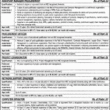Saad Iqbal | 🗓️Modified: August 30, 2016 | ⏳Read Time: 4 min | 👁Post Views: 2180
Bridge is basically a structure that is carrying a road, a path, railway etc. across a river, road or other obstable. It is a structure spanning and providing passage over a river, chasm, road or the like.
At the end of this post you will be able to understand :-
- What is a bridge?
- What are the different components of a bridge?
- What are parts of bridge superstructure?
- What are parts of bridge substructure?
- What are parts of bridge with diagrams?
- What is the girder of a bridge?
- What is the superstructure of a bridge?
After knowing what really the bridge is, lets move forward to the basic theme behind writing this post that what are the basic parts of a bridge.
Although the parts of the bridge is dependent on that what actually the bridge type is, and we all as a structural engineer know that there are many types of bridges, but here we will discuss the common parts every type of bridge have.
Everystructure in civil engineering has two basic portions one is called substructure and other is called super structure. Substructure is that part of the structure that is beneath the natural soil level NSL. It is usually the foundation that may be deep or shallow depending on the geotechnical properties of the bearing strata. Usually in the south Asia region the strata is not that much strong so usually piles are considered suitable and feasible.
Then the other part of the structure is the superstructure, in bridges the superstructure includes, the pier, abutments, transoms and the deck.
We will start from the substructure, first is the Pile and the Pile cap.
Piles and Pile Cap
Pile foundation is deep foundation that transfers the load to the underneath soil farther down to a good bearable strata. It is actually a long vertical selender member that bears the compression load and transfers the load either through surface friction or end bearing.
Depending on the loading conditions and the types of piles used, a group of pile is constructed underneath a pier. It may be a group of 9 or 12 depending upon the structural and geotechnical design. In order to uniformly transfer the load from the superstructure to the pile an intermediate slab is constructured which is deep enough to sufficient moment of intertia, that intermediate slab is called Pile Cap.
 |
| Parts of Bridges |
Pier
After the foundation pile and pilecap there comes a pier. A pier is just like a column which can be of uniform cross-section through its height or may be varying depending on the top deck width. Piers are actually compression members that also have to take care of some buckling or bending due to eccentric loading because of poor workmanship or for structural safety.
Pier Cap or Transom
It is actually the near to deck part of the bridge, It is that part on which bearings for girders will rest. They are responsible for transfer of load from girder to pier. They actually have a varying width at the top and plays important role as far as asthetics of a bridge is considered.
Bearing
As we all know that if we place the girder directly on the solid transoms then due to wear and tear as a result of the traffic movement the transoms or girders may get damanged. Thus they are saved by providing an end bearing usually some elastomeric so that can also work like a shock abrosber or as damping member.
Girders
The girders are just underneath the deck and are used to transfer the load of the deck to the bearings. They can be a box girder, U girder, I girder, inverted T girder or any other depending on the structural requirement.
Bridge Deck
It is the top surface on which the highway engineer will construct their flexible or rigid pavement. Bridge Deck is a slab that transfers directly the load of the traffic to the girders. The girders are made monolithic by using diaphragms and the top reinforcement of the girder is made to project in to the deck slab to make a perfect bond between them all.





















